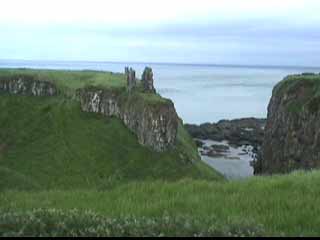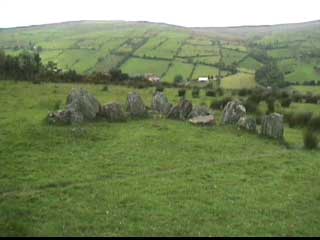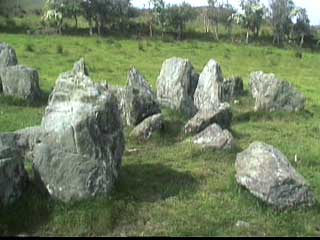Irish Dalriada
This is where "modern" history began, Angus' birthplace
at Dunseverick Castle in Northern Ireland. Angus was one of three brothers
who went north to settle Scottland. Aonghais, the Gaelic name, sounds out
to be Innes, Mac means those descendants of Angus, thus MacInnes is the family
line from Angus. With history from the time of Moses, intermingled with legends
like St. Patrick and St. Columba, Dalriada was first the name for the land
in Northern Ireland. Founded by Cairbre Riadia who settled in this area, and
later, the name was applied to the Scottish area where Angus, Lorne and Fergus
settled. Angus was the seafaring brother, having Jura and Islay as his lands.
The name MacInnes (mac Aonghais) is one the oldest name to remain from these
times.
There are several stories (and controversies)
about the origins of Dalriada detailed below. Did the three brothers go north
together as history claims, or did Fergus join Angus and Lorne already settled
in this area? History may never be able to tell the actual story of these
beginnings.
|
|
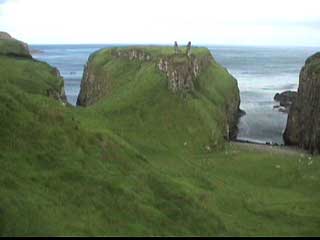 Looking straight on, a well protected area. Just beyond is the cave of Robert the Bruce. |
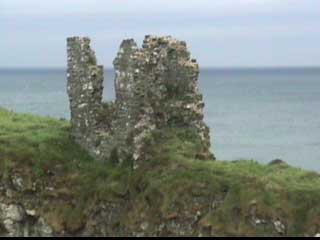 The more modern ruins. The original settling was further out to the left. |
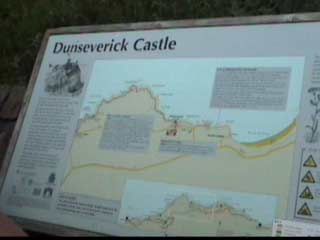 The sign and map. |
Mary Faulk, Clan MacInnes founder and historian, tells the story of our very early beginnings in the land they called Dalriada.
"In the time of Moses, so the legend goes, there was a lad named Gaodhal Glas who had been bitten by a serpent. Moses is said to have cured him and to have promised that `no serpent or other poisonous thing should infest the happy western island' that his descendants would one day inhabit. From Gaodhal they took the name Gaedheal or Gael.
Gaodhal's grandson, Niul, was invited to Egypt as an instructor. There he met and married the Pharaoh's daughter, Scota. He and his people prospered until, resentful of the injustice of a later Pharaoh, they were driven from Egypt. They wandered for a long time through Crete and Thrace finally reaching Spain. In Spain they heard of Ireland, perhaps from Phoenician traders. This they decided must be the Isle of Destiny foretold for them by Moses. Their leader at this time was Milesius whose wife was also named Scota. Milesius died in Spain, but Scota and their eight sons, their families and followers finally set out on the voyage to their Isle of Destiny. In later ages the land was called Scotia and the people were called Scotti.
Scota brought from Egypt a stone of black marble on which strange runes were carved. They landed in Ireland and fought the people there. Scota died in Ireland and later their was a warrior of the Goidelic line called Tuathal. He founded a kingdom at Tara.
By the fourth century the Scotti were assailing the Roman province of Britain. They filtered across to the Southern Hebrides and eventually to the mainland of the country that now bears their name. Bob Gilchrist writing in Argyll Colony Plus notes: `In Northern Ireland ... the Kingdom of Dalriada came to exist, being established by a Gaelic-speaking people whom the Romans had known as the warlike and tempestuous Scotti.'
Cairbre Riada, a descendant of Tuathal, had settled his people first in Munster, but famine caused him to abandon this land. He established a petty kingdom between the Antrim Mountains and the sea. He obtained this territory between 254 and 273 AD. The word `Riada', or `Righfadna', means `the long-armed'. Cairbre Riada was a nobleman of high parentage. His father was Conaire II, King of the Province of Ulster from AD 212 to 220 and his mother was the daughter of the illustrious Warrior King, Conn of the Hundred Battles.
The center of his kingdom was the ancient Dunseverick Castle set on a great rock rising sheer from the Atlantic in the strongest defensive position of Ireland's northern coast. Dunseverick was linked to Tara by one of the Great Roads and was an old fortress even in Cairbre Riada's day. The `Annals of the Four Masters' dates its foundation as being between 1692 and 1525 B.C. but this is no doubt an exaggeration. The correct date may well be nearer to 500 BC it was `Dun Schbairche', named after its first chieftain and the land in front of the castle still forms part of the townland of Feigh. The word `feigh' means `the green or park of a dun or fortress' and here the clansmen encamped when they came to pay their dues to their chief. In the 3rd century A.D. Dun Schbairche became the fortress capital of the Kings of Dalriada.
Cairbre Riada's kingdom was a small and narrow strip of coastal land, lying along the northern channel looking east towards Kintyre and the mountains of Lorne. One part later called "The Route" is regarded as extending from the Bann to the Bush; the other part stretched from the Bush to the sea at Lame and was later termed "The Glynnes" or the Glens of Antrim. Cairbre Riada passed his territory on to his descendants and by doing so gave to it the name `Dahiada'. `Dal' means `descendants' and in a secondary sense `the territory of the descendant'. The word `Dalriada' therefore signifies 'the territory of the descendants of Cairbre Riada.
Cairbre Riada's heir, Eochach Dubhlein, married a Pictish princess, the daughter of the Albain King Obdaire. She bore him three sons, known in legend as the `three Collas'. The oldest, Colla Uais, aspired to the High Kingship of Tara but was defeated by a cousin. He and his brothers fled to Alba (possibly to Colonsay). In due time they returned to Ireland and they won swordland and founded a Kingdom called Oriel.
Saint Patrick visited Dunseverick several times on his missionary journeys. On the first occasion he converted the king to Christianity. This king was Erc, twelfth in descent from Cairbre Riada. Cairbre Riada's descendants ruled the coast area of Antrim until Colla Uais grandson, Erc of Dalriada, died. Erc had twelve sons, the youngest being Fergus, Lorn and Angus. The recorded history of Argyll begins in the 5th Century AD when it was invaded by the Scotti (Celts). The Scotti were the Gaelic-speaking people who had gained ascendancy in the north of Ireland.
One legend says that Erc had provided an annual sum to help support the work of the missionaries who were spreading Christianity throughout their world. After his death, his elder sons, resenting this expense and desiring to keep the money, decided to stop the payments. Fergus objected arguing that it would have been Erc's wish for the annual stipend to the monks to continue. He was overruled by his older brothers. Fergus was very unhappy at their decision so he sailed for Scotland accompanied by his brothers. Loth and Angus.
Another story is that on his last visit to Dunseverick Castle, St. Patrick found the twelve sons of Erc in the sovereignty of the Kingdom of Dahiada owing to the death of their father. Fergus, the youngest son, was not given a part of the inheritance. St. Patrick intervened on his behalf and made this famous prophecy about Fergus. He said "though thy brother hath not such respect for thee today, it is thou that shall be king. The Kings of this country and over Fortrenn (Scotland) shall be from thee for ever."
Historically we know that in the beginning of the sixty century, about the year 502 AD, Fergus, with Lorne and Angus, led a great organized invasion of the Scotland coast by the warriors of Dalriada. They successfully occupied the area now know as Argyll and some of the islands including Islay. Thus the Dalriadic settlement in Argyll was founded by the three sons of Erc. These Scotti come to colonize the west Highland fringe known as Dalriada or Oirir-Chaidhell, Argyll, or `the Coastland of the Gael' (Note A).
Fergus established himself as king over this area which came to be known as the Second Dalriada. Fergus and his men were known as Scotti and they gave this name to the whole country. He chose as the center of his kingdom a site on a hillock known as Dunadd. Dunadd was the capital of Dalriada for about 345 years. The early fort sat upon a rocky knoll, thirty metres high, in the centre of the plain of the Great Moss, four miles northeast of Lochgilphead. This was the seat of Fergus Mac Erc and it is said that he brought with him from Ulster the Lia Fiall - Jacob's Pillow - later to be known as the Stone of Destiny. A hillock and a rock are all that remain. Historians believe that this was the place where kings were crowned; that St. Columba crowned Aidan here in 574 AD using the disputed Stone of Destiny as the throne.
The earliest reference to the sons of Angus is given in the 7th Century "Senchus Fer n Alban" (History of the Men of Scotland). As early as the 6th century Dalriada was divided among three tribes: the Cineal Gabran (son of Fergus), the Cineal Loth and the Cineal Angus. This division of Argyll among the tribes is probably the earliest instance of the division of the race into district clans that became general in the Highlands some centuries later. Of the three brothers, Angus chose as his territory the Isles of Islay and Jura. Lorn chose the region about Obhan (Loth). Fergus established himself in Kintyre. It is said that although Angus could not muster as many men as his brothers his naval commitment was by far the greatest. Cineal Angus could contribute two 7-bench boats for every twenty houses.
Angus was the first of the three brothers to die. He was `buried in Icolmkill' (the Isle of Iona). The burial place of the early Scottish kings was the island of Iona in the `Sepulchre of Kings'. No stones or markers identify these early graves. He left a son, Muredach, who succeeded him in the government of Ila (Isle of Islay)."
| References: | Faulk,Mary. A part of the story from Clan MacInnes The Thistle and the Bee March 2000 |
| John O'Hart. Irish Pedigrees; or the Origin and Stem of the Irish Nation p49 1852 |
It is thought that Fergus was not a brother of Angus and Lorne, but that Angus and Lorne already existing in Scotland and knew Gaelic when Fergus came north. All spoke what is called Q-Celtic, or Brittonic Gaelic. P-Celtic was spoken by Pictish, Welsh, Breton and Cornish. All Q-Celtic speaking people were called Scotti. Due to politics to be part of the lineage of the kings, later chronicles and poets created the "tripartite brotherhood" to explain the relation between the three. Ewan Cambell even suggests that Scottish Dalriada may have come down to Ireland and invaded it!
There are several factors Ewan claims that support these claims. In what history is available, the tribes (Cinel) of Angus and Lorne are well established in the area of Scottish Dalriada by way of family names. The Fergus name does not appear until a later time. The Senchus and the Irish "Book of Munster" support both names of Angus and Lorne. Ewan Cambell sites housing structures called ringforts, existing in Ireland while not in Scotland, although the land would support such structures. Crannogs exist in Scottland, that date to the iron age (500BC) while structures in Ireland seem to be around 600AD. Jewelry worn to denote tribe association differs in the two regions. Scotland had rectangular terminals with beveled edges, while Ireland used animal heads. Monuments called ogham pillars were used in Ireland from the 5th to 7th centuries and are widely found in Ireland. Only two in Argyll have been discovered. Ewan states that the Gaelic speaking people were "always there" but does not bolster his argument why two areas in close proximity would just happen to have Gaelic speaking people.
'Saints and Sea Kings by Ewan Cambell Canon gate books with Historic Scotland.
"The earliest tradition concerning the Irish settlement of western Scotland comes from a tenth-century copy of a seventh-century document known as as the Senchus fer nAlban (Tradition of the Men of Scotland). The Senchus is a kind of Doomesday Book, listing holdings in Argyll and also providing a muster of land and sea forces. It is concerned with lineages (the Irish word 'Cenel', perhaps best translated as 'people'. The Senchus shows that the colonization was spearheaded by Fergus, son of Erc, the descendent of Nes (possibly a river Goddess), who came with his brothers and established control before dying in 501. It would seem that Fergus' main area of activity was Kintre. The Senchus also records that Fergus' brothers, Loarn and Oengus, established themselves in Lorn (where the lineage became Cenel Loairn) and Islay (where the line was that of Cenel nOengusa). This all seems too neat an explanation for the origins of the three divisions of Dalriada. Modern opinion favours the view that the 'son' of Fergus were invented to account for an earlier migration to Argyll from Ireland, where Cenel n'Oengusa was already established before Fergus' 'time'."
'The Picts and the Scots' by Lloyd and Jenny Laing Allan Sutton Publishing Limited.
Lloyd and Jenny Laing also think that Cairbre Riada had an expedition of people some 10 generations earlier than Fergus that were in the area. Because the language was already familiar, there was little conflict. Trips were common between Ireland and Scottland because of the short distance and common language. History does not suggest any major battle for Dalriada. One other source suggests a people that came about the time of Cairbre Riada.
The history of the times around 500AD are not certain. John Bannerman has interpreted an Irish document in his book Studies of the History of Dalriada. The document,Senchus Fer n Alban or Tradition of the Men of Scotland, from the Book of Ballymote. The Senchus was thought to be written about 650 AD, but may have been altered around 1000AD to reflect the feelings at that time. Helen McSkimming, a noted author of the Dalriada Celtic Heritage Trust also agrees with John's findings and is planning to write an article in the near future.
Several references are listed here for further reading, as the number of names and places become overwhelming to the less academically inclined. Be forewarned that one will find numerous spellings of the names (Angus, Aonghias, Oengus, Cenel nOengusa - the people of Angus; Lorne Loarn, Laurin, Loairn, Loth) and the many derivatives somewhat daunting.
| References: | Bannerman, John. Studies in the History of Dalriada. 1970's |
| McSkimming, Helen. Dal Riata Divisions of the Land and the People, Part 1&2, the Origins of Dal Riata. Dal Riata Publishing. Vol 14 Issue 4 1999, Vols 15 Issues 1 &4 2000. | |
| Campbell, Ewan. Saints and Sea-Kings. Historic Scotland. | |
| Laing, Lloyd and Jenny. The Picts and the Scots Allan Sutton Publishing Limited |
Ossian's Grave
back to top
Ossian was the legendary Gaelic warrior-bard of the 3rd century, now buried on a hill in Northern Ireland not far from Dunseverick Castle. Ossian was the supposed son of Finn Mac Cumhail (also known as Fionn mac Cumhail, or Finn MacCool). Ossian's poetry talks about the Irish heros Finn in the 3rd century and his exploits, and also Cuchulain (Cu Chulainn). In the 1760's Scottish poet James MacPherson took the work as his own, which inspired much of the Gaelic poetry in the late 18th and early 19th century Scotland. Ossian's tales were one of few details of the early times.
Ossian is a relative in the line of Clan MacInnes. Ossian
would be a great great Uncle of Erc, father of Angus.
|
|
|
|
A semi-circle of stones near the grave (cairne)
|
A close up of the cairne
|
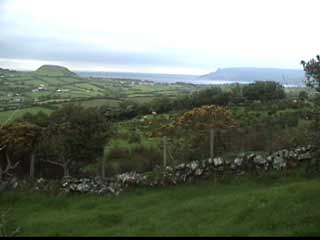 |
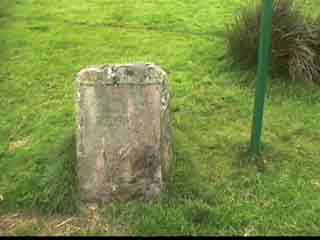 |
|
The hillside view from the grave
|
The marker (actual grave?)
|
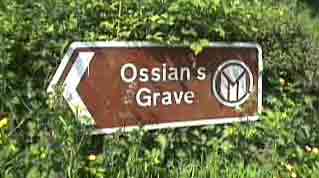 |
|
|
Road sign marking the site. It is about a 1/4 mile
hike up to the actual grave on the hill.
|
|
back to top
